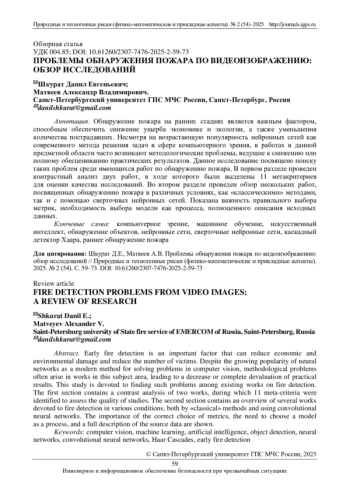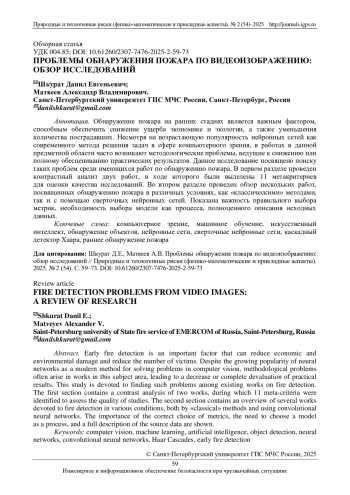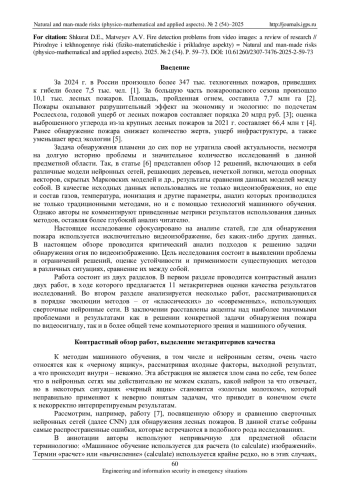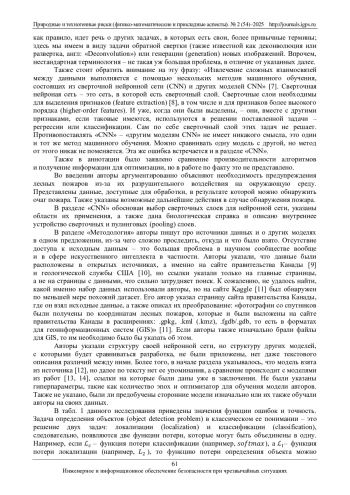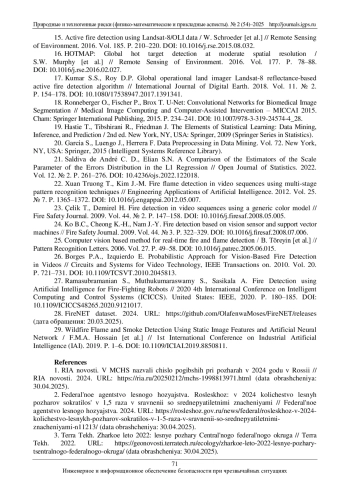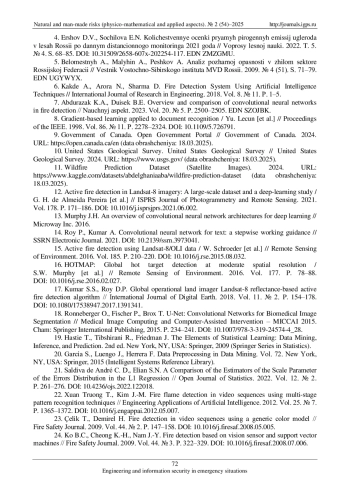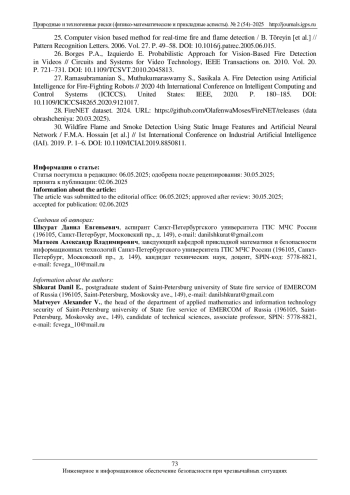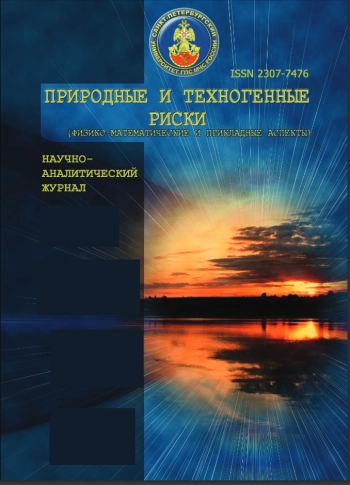1. РИА новости. В МЧС назвали число погибших при пожарах в 2024 году в России // РИА новости. 2024. URL: https://ria.ru/20250212/mchs-1998813971.html (дата обращения: 30.04.2025).
2. Федеральное агентство лесного хозяйства. Рослесхоз: в 2024 количество лесных пожаров сократилось в 1,5 раза в сравнении со среднепятилетними значениями // Федеральное агентство лесного хозяйства. 2024. URL: https://rosleshoz.gov.ru/news/federal/rosleskhoz-v-2024-kolichestvo-lesnykh-pozharov-sokratilos-v-1-5-raza-v-sravnenii-so-srednepyatiletnimi-znacheniyami-n11213/ (дата обращения: 30.04.2025).
3. Терра Тех. Жаркое лето 2022: лесные пожары Центрального федерального округа // Терра Тех. 2022. URL: https://geonovosti.terratech.ru/ecology/zharkoe-leto-2022-lesnye-pozhary-tsentralnogo-federalnogo-okruga/ (дата обращения: 30.04.2025).
4. Ершов Д.В., Сочилова Е.Н. Количественные оценки прямых пирогенных эмиссий углерода в лесах России по данным дистанционного мониторинга 2021 года // Вопросы лесной науки. 2022. Т. 5. № 4. С. 68–85. DOI: 10.31509/2658-607x-202254-117. EDN ZMZGMU.
5. Беломестных А., Малыхин А., Пешков А. Анализ пожарной опасности в жилом секторе Российской Федерации // Вестник Восточно-Сибирского института МВД России. 2009. № 4 (51). С. 71–79. EDN UGYWYX.
6. Kakde A., Arora N., Sharma D. Fire Detection System Using Artificial Intelligence Techniques // International Journal of Research in Engineering. 2018. Vol. 8. № 11. P. 1–5.
7. Abdurazak K.A., Duisek B.E. Overview and comparison of convolutional neural networks in fire detection // Научный аспект. 2023. Vol. 20. № 5. P. 2500–2505. EDN SZOJBK.
8. Gradient-based learning applied to document recognition / Yu. Lecun [et al.] // Proceedings of the IEEE. 1998. Vol. 86. № 11. P. 2278–2324. DOI: 10.1109/5.726791.
9. Government of Canada. Open Government Portal // Government of Canada. 2024. URL: https://open.canada.ca/en (дата обращения: 18.03.2025).
10. United States Geological Survey. United States Geological Survey // United States Geological Survey. 2024. URL: https://www.usgs.gov/ (дата обращения: 18.03.2025).
11. Wildfire Prediction Dataset (Satellite Images). 2024. URL: https://www.kaggle.com/datasets/abdelghaniaaba/wildfire-prediction-dataset (дата обращения: 18.03.2025).
12. Active fire detection in Landsat-8 imagery: A large-scale dataset and a deep-learning study / G. H. de Almeida Pereira [et al.] // ISPRS Journal of Photogrammetry and Remote Sensing. 2021. Vol. 178. P. 171–186. DOI: 10.1016/j.isprsjprs.2021.06.002.
13. Murphy J.H. An overview of convolutional neural network architectures for deep learning // Microway Inc. 2016.
14. Roy P., Kumar A. Convolutional Neural Network for Text: A Stepwise Working Guidance // SSRN Electronic Journal. 2021. DOI: 10.2139/ssrn.3973041.
15. Active fire detection using Landsat-8/OLI data / W. Schroeder [et al.] // Remote Sensing of Environment. 2016. Vol. 185. P. 210–220. DOI: 10.1016/j.rse.2015.08.032.
16. HOTMAP: Global hot target detection at moderate spatial resolution / S.W. Murphy [et al.] // Remote Sensing of Environment. 2016. Vol. 177. P. 78–88. DOI: 10.1016/j.rse.2016.02.027.
17. Kumar S.S., Roy D.P. Global operational land imager Landsat-8 reflectance-based active fire detection algorithm // International Journal of Digital Earth. 2018. Vol. 11. № 2. P. 154–178. DOI: 10.1080/17538947.2017.1391341.
18. Ronneberger O., Fischer P., Brox T. U-Net: Convolutional Networks for Biomedical Image Segmentation // Medical Image Computing and Computer-Assisted Intervention – MICCAI 2015. Cham: Springer International Publishing, 2015. P. 234–241. DOI: 10.1007/978-3-319-24574-4_28.
19. Hastie T., Tibshirani R., Friedman J. The Elements of Statistical Learning: Data Mining, Inference, and Prediction / 2nd ed. New York, NY, USA: Springer, 2009 (Springer Series in Statistics).
20. García S., Luengo J., Herrera F. Data Preprocessing in Data Mining. Vol. 72. New York, NY, USA: Springer, 2015 (Intelligent Systems Reference Library).
21. Saldiva de André C. D., Elian S.N. A Comparison of the Estimators of the Scale Parameter of the Errors Distribution in the L1 Regression // Open Journal of Statistics. 2022. Vol. 12. № 2. P. 261–276. DOI: 10.4236/ojs.2022.122018.
22. Xuan Truong T., Kim J.-M. Fire flame detection in video sequences using multi-stage pattern recognition techniques // Engineering Applications of Artificial Intelligence. 2012. Vol. 25. № 7. P. 1365–1372. DOI: 10.1016/j.engappai.2012.05.007.
23. Çelik T., Demirel H. Fire detection in video sequences using a generic color model // Fire Safety Journal. 2009. Vol. 44. № 2. P. 147–158. DOI: 10.1016/j.firesaf.2008.05.005.
24. Ko B.C., Cheong K.-H., Nam J.-Y. Fire detection based on vision sensor and support vector machines // Fire Safety Journal. 2009. Vol. 44. № 3. P. 322–329. DOI: 10.1016/j.firesaf.2008.07.006.
25. Computer vision based method for real-time fire and flame detection / B. Töreyin [et al.] // Pattern Recognition Letters. 2006. Vol. 27. P. 49–58. DOI: 10.1016/j.patrec.2005.06.015.
26. Borges P.A., Izquierdo E. Probabilistic Approach for Vision-Based Fire Detection in Videos // Circuits and Systems for Video Technology, IEEE Transactions on. 2010. Vol. 20. P. 721–731. DOI: 10.1109/TCSVT.2010.2045813.
27. Ramasubramanian S., Muthukumaraswamy S., Sasikala A. Fire Detection using Artificial Intelligence for Fire-Fighting Robots // 2020 4th International Conference on Intelligent Computing and Control Systems (ICICCS). United States: IEEE, 2020. P. 180–185. DOI: 10.1109/ICICCS48265.2020.9121017.
28. FireNET dataset. 2024. URL: https://github.com/OlafenwaMoses/FireNET/releases (дата обращения: 20.03.2025).
29. Wildfire Flame and Smoke Detection Using Static Image Features and Artificial Neural Network / F.M.A. Hossain [et al.] // 1st International Conference on Industrial Artificial Intelligence (IAI). 2019. P. 1–6. DOI: 10.1109/ICIAI.2019.8850811.
